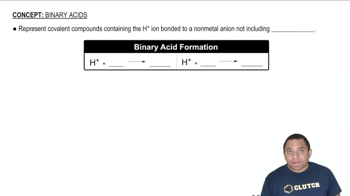Here are the essential concepts you must grasp in order to answer the question correctly.
Binary Compounds
Binary compounds consist of two different elements. In chemistry, these compounds can be ionic or covalent, depending on the nature of the bonding between the elements. Understanding the type of binary compound is essential for determining the correct naming conventions.
Recommended video:
Ionic Compounds
Ionic compounds are formed when metals transfer electrons to nonmetals, resulting in the formation of charged ions. In the case of CuO, copper (Cu) is a metal that forms a cation, while oxygen (O) is a nonmetal that forms an anion. Recognizing the ionic nature of CuO is crucial for applying the appropriate naming rules.
Recommended video:
Systematic Naming (IUPAC Nomenclature)
The systematic naming of compounds follows specific rules set by the International Union of Pure and Applied Chemistry (IUPAC). For binary ionic compounds, the name typically consists of the cation's name followed by the anion's name with an '-ide' suffix. For CuO, the systematic name is copper(II) oxide, indicating the oxidation state of copper.
Recommended video:
 Verified step by step guidance
Verified step by step guidance


